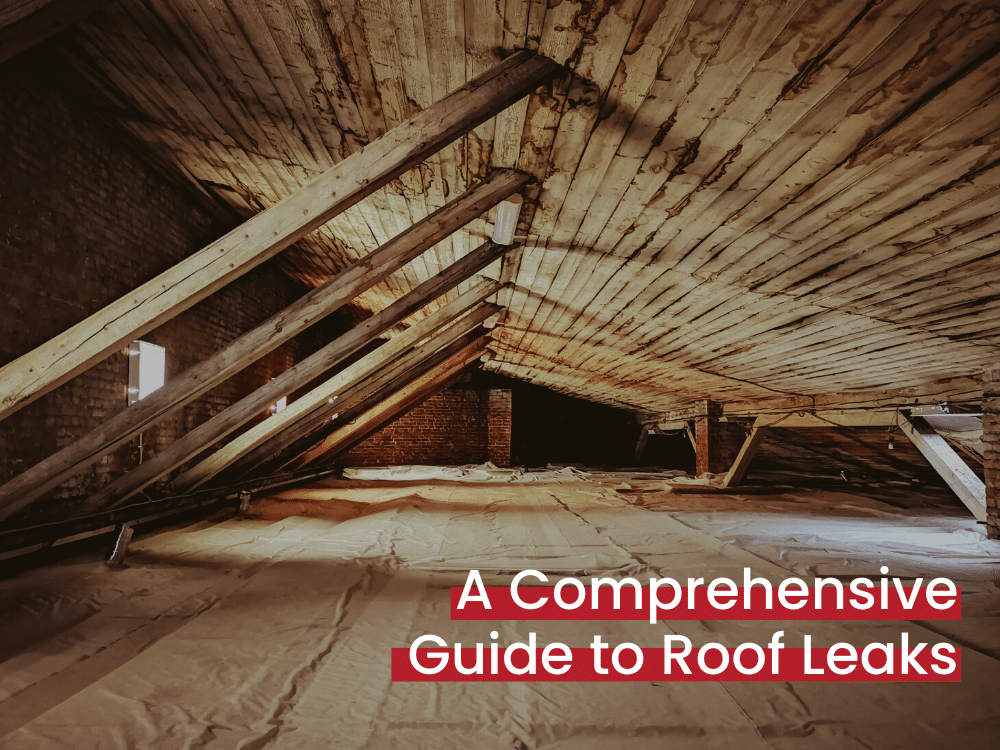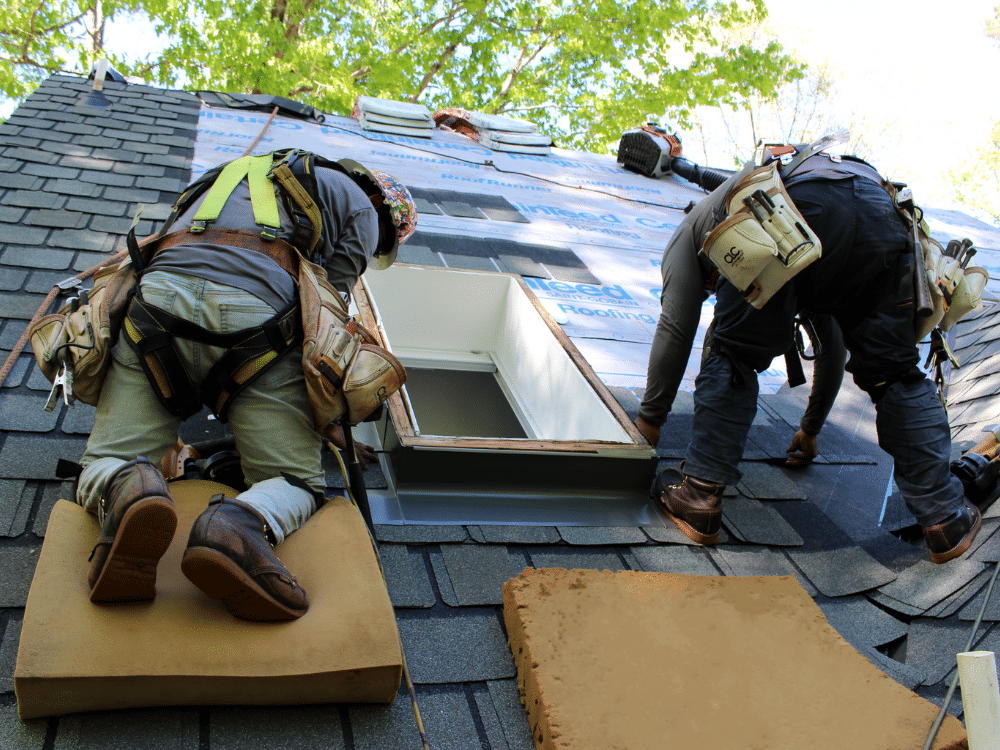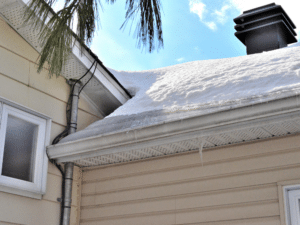
Don’t roof leaks have the worst timing? Your life is already so busy, the last thing you want to deal with is a wet ceiling. To prepare you for any present or future leaks, we’ve put together a little (or not so little, more like a super thorough) guide for you.
We’ll cover:
In this guide, we will answer all these questions…and then some! Let’s get started.
Pinpointing roof leaks: Ask “Where?”

The location of your leak is the key indicator of the cause of the leak. Let’s take look at the different leak areas you could find around your house.
Vents and Pipes:
Do you see water spots or dripping coming from a vent in your house?
Your bathroom ceiling has exhaust vents that let out onto your roof. Every vent has a vent cover on the roof. Over time, the covers can get smashed, rust, or develop nail pops. In some instances, the vent can fail early on if installed improperly (exposed nails). And, you’ve guessed it, cause a roof leak.
As a side note, extremely heavy, wind-driven rains might allow minimal water into your vent covers.
Do you see water dripping down pipes in your attic space?
Most plumbing systems have PVC exhaust pipes that let out through the roof. Roofers use roof boots to seal the areas between the shingles and the pipes. Boots are the black rubber or plastic pieces on your roof that look like plungers. Typically, roof boots last 8-10 years. After that point, they will need a resealing or replacement. Otherwise, the sealant between the PVC pipe and the boot will disintegrate and let water in.
Vent and pipe replacements are minor repairs and only cost a few hundred dollars, depending on the number of boots or vents that need replacement.
Skylights:

If there is leaking around or near your skylight, either your skylight or skylight flashing is damaged. Depending on the age of the flashing and skylight, you’ll need either a skylight repair or replacement.
Skylights are incredibly water-tight, often having multiple layers of glass. However, skylights don’t last forever; most manufacturers guarantee 20 years. After that 20-year mark, the sealant around the glass can deteriorate and allow water in through the seams. Resealing around the glass provides only a short-term temporary fix at best.
The skylight flashing – the metal around the skylight that connects it seamlessly to the roof – has a similar life span and might need maintenance partway through its life.
After your skylight hits 20 years, if it starts to develop issues, we recommend a full skylight replacement. Replacing your skylight is much more cost-effective in the long run. If you try to just patch the leak, it will be a short-term fix that’ll need more repairs later. On top of that, the area could still incur more interior water damage.
If a full skylight replacement isn’t in the budget right now, ask your roofer about a short-term fix to seal it until you are able to replace it. While not ideal, this is better than leaving the issue unchecked. Another cheaper, long-term solution is to remove and shingle over the skylight. Although this is a larger repair, it is much cheaper than a brand new skylight and flashing kit.
Whatever route you go, make sure your roofing contractor also replaces any damaged sheathing or underlayment. Otherwise, you’ll have unchecked water damage right below the shingles and around the skylight.
Chimney:
A leak near or around your chimney has a few potential causes. We’ll cover each below.
1. Chimney chase cover
You might have a faulty or rusted chimney chase cover. A chimney chase acts as a covering over your chimney to keep rainwater and debris from coming in through the exhaust area. If your cover is damaged, it’ll need a replacement.
2. Chimney flashing
One common water-entry point is the area where your chimney meets your roof shingles. That being said, a quality roofing crew will replace all the flashing around your chimney during a roof replacement.
Unfortunately, many roofing companies cut corners by not replacing the flashing. Even when they do replace the flashing, many roofers do it incorrectly. At Artisan, many homeowners call us and ask for a chimney reflashing because of the bad workmanship from their previous roofer.
Artisan always replaces the chimney flashing during their roof replacements, and we’ve thoroughly trained our crew and technicians in the proper installation techniques.
3. Chimney brick or siding
If you have an older chimney with siding, you might have some wood rot along the chimney. When your siding is wet and rotted, water can seep through it and into your house. For this repair, you would need to hire a siding contractor to replace the damaged siding.
If you have a brick or stone chimney, there could be cracks in the mortar that allow water in. For this repair, we recommend hiring a chimney expert to take a look and perform the repair.
Ceiling water spots
This is the broadest leak category. Many different types of leaks (roofing or plumbing related) cause ceiling water marks.
When you have a roofing expert inspect the leak, we recommend explaining clearly where the water spot is. Also ask them to inspect the attic area and look at the water spot. This will help them accurately pinpoint the cause of the leak.
Since ceiling water spots could have many causes, try going into the attic space to see if you can locate any wet areas up there.
Potential causes:
- Nail pops
- Missing, cracked, or lifted shingles shingles
- Disintegrated/old shingles
- Exposed nails
- Loose or damaged flashing
- Rotted sheathing where shingles have worn down over time
- No underlayment (or poor quality underlayment)
- Overflowing gutters
- Windows or siding
Pricing for this sort of repair varies based on the size of the area, number of areas, and extent of water damage.
As a side note, some leaks act like roof leaks, but the leak is unrelated to your roof. If you hire a quality roofing contractor, they will be honest with you and inform you whether or not it’s truly a roof leak.
Leaks unrelated to roofs

Finally, there are the tricky leaks disguised as roof leaks. When your ceiling is leaking, it’s easy to assume your roof is too. However, we do come across many cases where the leak has nothing to do with the roof.
If a home has older windows or siding and you get hit with a heavy, wind-driven rain, water could enter through the windows and siding. For vinyl siding, even the newest siding can sometimes allow water in during windy rains if there isn’t proper waterproofing behind the siding.
But it’s not just siding. For brick homes, the mortar beds can wear away over time, creating another water entry point.
Lastly, the leak may not be related to your home exterior at all. Your HVAC unit, hot water heater, and plumbing could all develop issues and water leaks.
Luckily, if you call an honest roofing expert, they’ll be able to inspect the area to determine whether or not it’s a roof leak. However, we also recommend trying to determine the specific location of the leak and seeing if there are any old systems nearby, whether it be windows, siding, brick, or plumbing.
Roof Leak Repair Costs
At this point, you’re probably wondering how much money you should expect to spend for a repair. Costs vary by region and company, but we have put together a general guide below.

How to prevent roof leaks:
Obviously, the cheapest “repair” would be to prevent the leak in the first place. Let’s discuss a few actions you can take to protect your home from roof leaks.
1. Do a DIY Maintenance Check:
We recommend performing a regular roof maintenance check 1-2 times a year. This can be as simple as taking a few minutes to walk around your property and look at your roof. Check to see if anything looks out of the ordinary.
If something does look amiss, you can always call a roofing contractor for a roof inspection.
2. Have Roof Maintenance Work Done:
Secondly, according to our roofing experts here at Artisan, you should have your roof inspected every 8 years. The main reason for this is because, while roof boots are meant to last 10 years, they often fail after 8. That being the case, you’ll want a roof inspection before any roof boots fail and cause leaks.
During these inspections, your roofer can check for any areas that might need maintenance. While onsite, they can also check for storm damage.
The most common age for a roof replacement is about 20 years. At that point, your roofer can tell you if your roof needs repairs or a full replacement. If your roof still has some life left, they can tell you how much longer it should last (barring any storms).
3. Keep Your Roof Clean:
Finally, keep your roof clean. Debris build-up on your roof leads to algae growth, mold, moss, and soil deposits. Each of these will break down your shingles. Furthermore, they will trap in moisture, and the built-up moisture can cause a roof leak.
If you live in a heavily wooded area, have your roof blown off during your regular gutter cleanings. Does your roof still look dirty? Consider hiring a professional roof cleaner to wash off your roof.
However, if you do hire a roof cleaner, talk to your roofing contractor first to make sure the cleaning won’t void your roof warranty.
In addition, check to make sure they use a gentle cleaner and are careful around valleys and areas with flashing. These areas are more prone to leakage. Think of these areas like the seams on your clothes. Just like your clothing seams are weak points prone to ripping, so the seams of your roof are weak points prone to leaks.
What to do when you have roof leaks

So it’s happened. Your roof is leaking. First things first: take a deep breath, and don’t worry. In the end, everything will be okay; we promise! Once you’ve taken a moment to wrap your head around the situation, we recommend these next steps:
Step 1: Locate the leak.
To start, go into the attic space and find the water entry point. Place buckets, containers, or towels underneath the area. If there is no attic space, place a container or towels under the leak.
Step 2: Take photos.
Next, while your roof is actively leaking, take photos of the interior to show the roofing contractor. If you are willing and able, get some photos in the attic space, too. That way, if a roofing contractor is unable to come out immediately, you will have the photos for reference.
Step 3: Call in an expert.
Lastly, call a local, well-rated roofing expert to take a look and perform the necessary repairs. This way, you can have peace of mind that it’s quality, watertight work.
Also, don’t forget to ask about their repair warranty. You want to make sure there is a warranty for the repair work. That way, if it is a tricky leak that the initial repair did not fix, the roofer will come back out again to fix it at no charge.
(Sidenote: this is also why you want to choose a local company. Should you have different issues down the road, you will have a go-to roofing expert who knows your roof. They’ll also have a record of any previous work done.)
Concluding Thoughts:
Of course, “Out of sight, out of mind” is the easiest route to take,…until your roof starts leaking. But we promise prevention is always easier (and cheaper) than a repair. Prevention will also give you peace of mind knowing your roof is secure even during the stormy seasons.
All in all, the best form of prevention is a roof tune-up. At Artisan, during a roof tune-up, we walk the entire roof, inspect for any problem areas, and perform any necessary maintenance like correcting nail pops, securing or sealing flashing, and replacing roofing boots.
Need a roof inspection or tune-up? At Artisan, we have our own in-house team of technicians who are incredibly talented at pinpointing leaks. We also have a local office with a team dedicated to serving and taking care of our customers. That means we are here for you before, during, and after the repair for anything you need.

